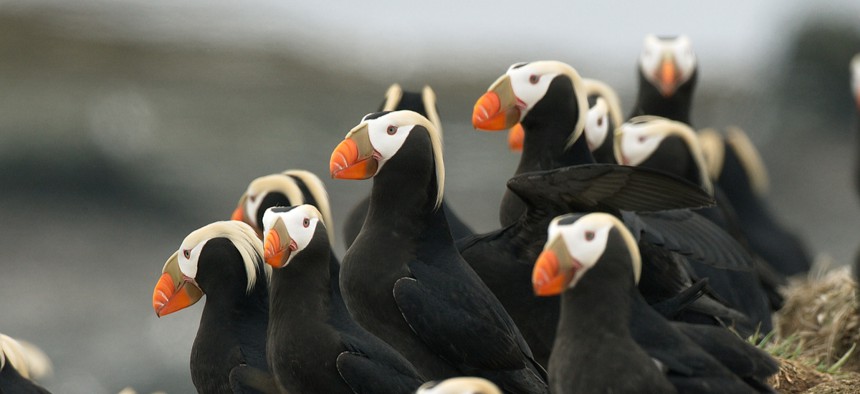It’s no coincidence that most of the tufted puffins that washed up during St. Paul’s mass-mortality event were in the middle of molting. At a time when they were most in need of food, and least able to get it, the dwindling sea ice forced them to travel farther afield for sparse, energy-poor scraps. “In short, climate change causes seabird starvation,” says Melanie Smith, the conservation director for Audubon Alaska. “It’s not the only factor at play, but it is the common thread among similar events.”
Other species in the Bering Sea are suffering, too. Ever since 2013, when the massive marine heatwave known as “the blob” formed off Alaska, “we’ve seen a whole bunch of mass-mortality events,” says Parrish, who documented a similar die-off of Cassin’s auklets in 2015. “In every case, there are thousands to hundreds of thousands of marine birds that should normally be way offshore, but are crowding into pretty narrow strips of coastal land. They can’t keep it together, they’re starving to death, and they’re washing in.”
“Bird die-offs have happened up there before,” says Phyllis Stabeno, an oceanographer at the National Oceanic and Atmospheric Administration. “But it’s unusual for there to be so many of them, spread out over the whole [Bering Sea] system.”
“It’s an ecosystem that, in my experience, is screaming constantly at us to pay attention,” Parrish adds.
Kathy Kuletz from the U.S. Fish and Wildlife Service adds that most mass-mortality events probably go unrecorded, because they happen out at sea, and the carcasses never make it to shore. “Our office has conducted about 15,000 to 20,000 kilometers of seabird surveys annually since 2007, and before 2014, we averaged 1 to 2 dead bird encounters per year at sea,” Kuletz says. “Since then, we've had between 20 and 70 dead birds per year. Those numbers may not seem like much, but bird carcasses are difficult to see from large vessels moving at 10 to 14 knots, so this could represent a much larger problem than is documented by monitoring efforts on land.”
These changes are also affecting the people who live on St. Paul and the other Pribilof Islands. The native Aleut, or Unangan, people have long traditions of hunting puffins and collecting their eggs. The birds aren’t that important as a food source now, but they’re still culturally significant. “People enjoy having them around,” Divine says. “When the community saw the die-off, it was alarming and upsetting. They wanted to know what is happening to the species, and what management measures the federal government will take to understand and fix this situation.”
Other seabird populations are declining, too, Divine says. Several species roost on cliff faces, and without sea ice to buffer the coast from fierce winter storms, those cliffs are eroding at an alarming rate. The shorelines are wearing away, too, destroying the breeding sites where endangered Steller sea lions would normally congregate. “Their numbers here have gone to almost zero,” Divine says. “These huge biological and physical changes are very noticeable in the Pribilofs. We’re in the middle of it all.”
And yet, the exact scope of those changes is hard to assess, because the Pribilofs are so remote, and because censuses of seabirds rarely attract significant funding. Only through the efforts of Divine’s team of volunteers did the extent of the puffin die-off become clear. “Everything up here is data limited,” says Austin Ahmasuk of Kawerak, a consortium of Alaska Native tribes. “We only know about [the puffins] thanks to this citizen effort.”
“This is a sad bird story, but it’s also one about how community science and mainstream science can work together,” Parrish adds. “Listening to local expertise and incorporating that into what we do … that’s the only way science is going to save the world.”






